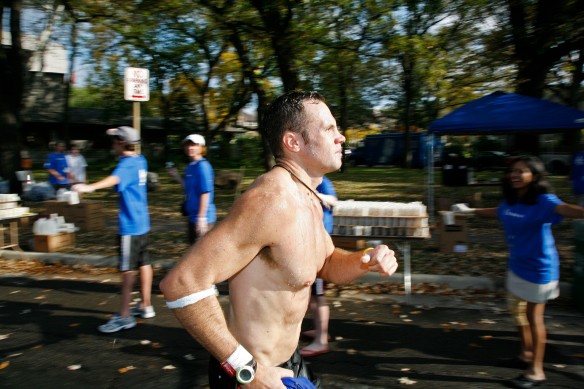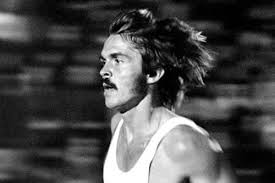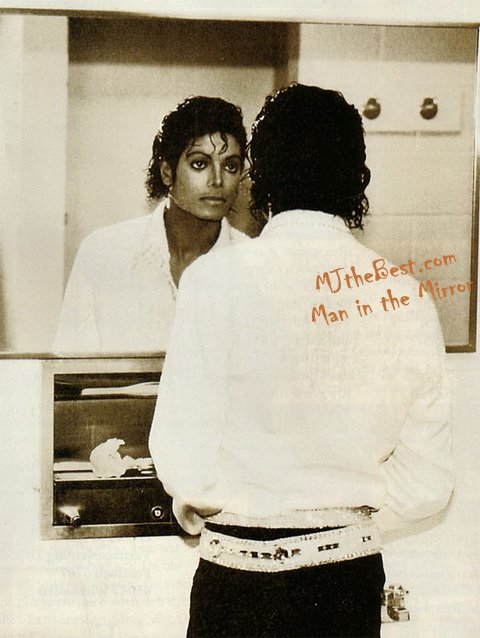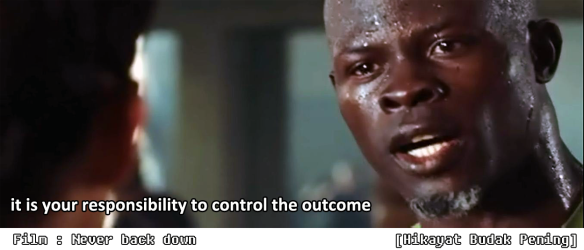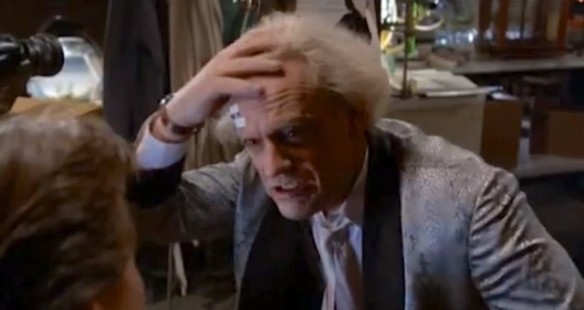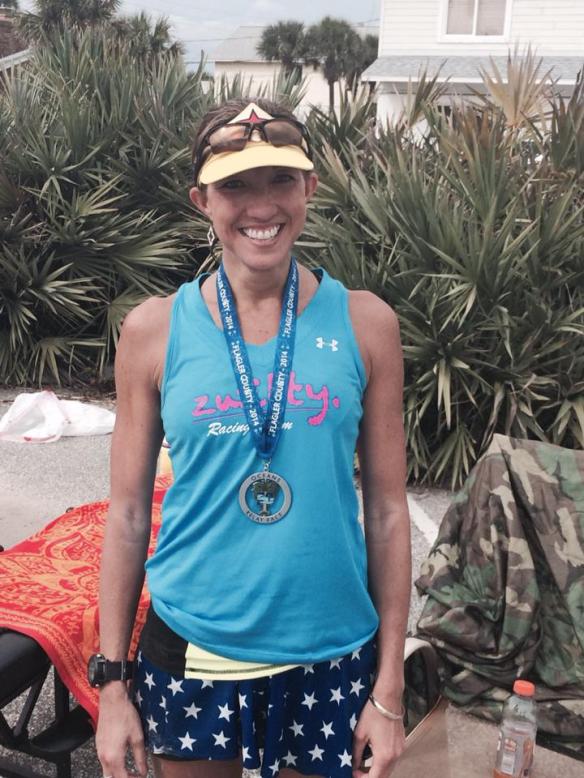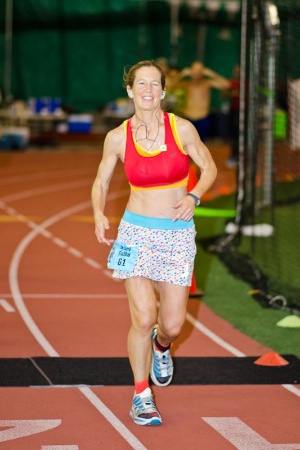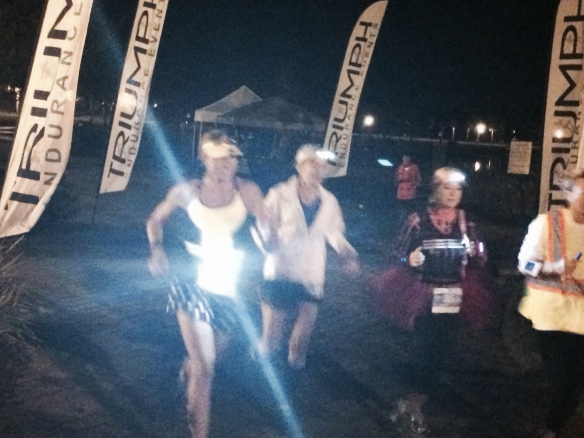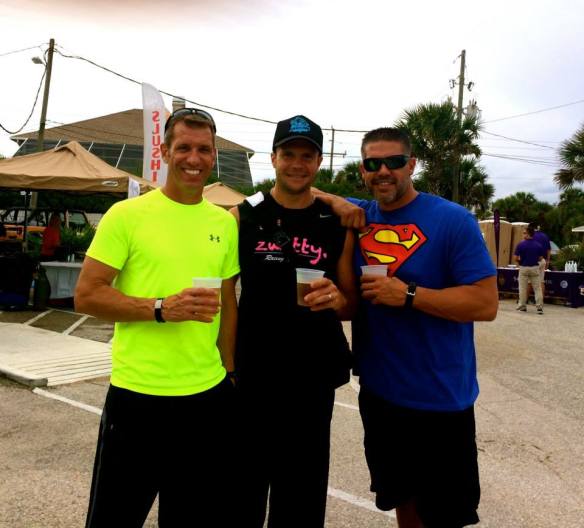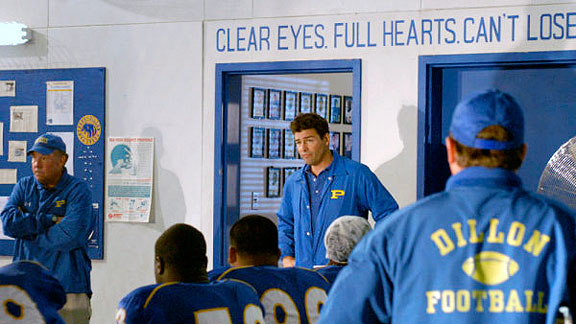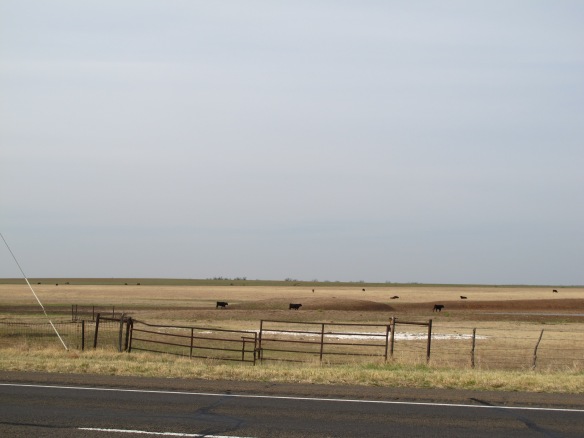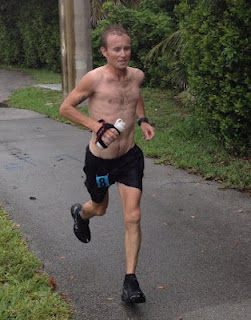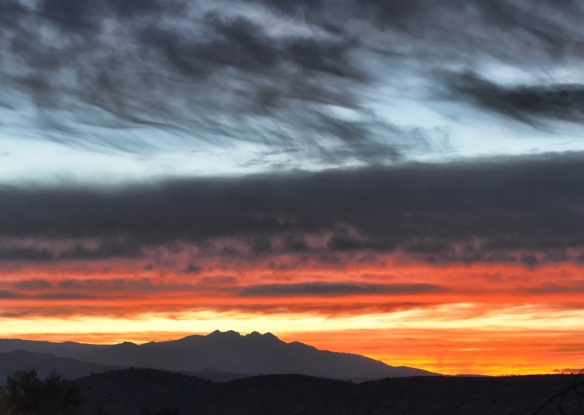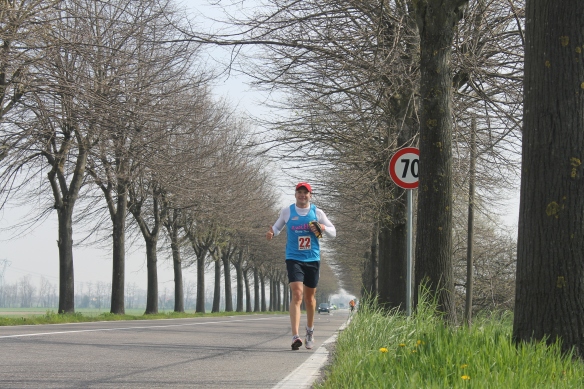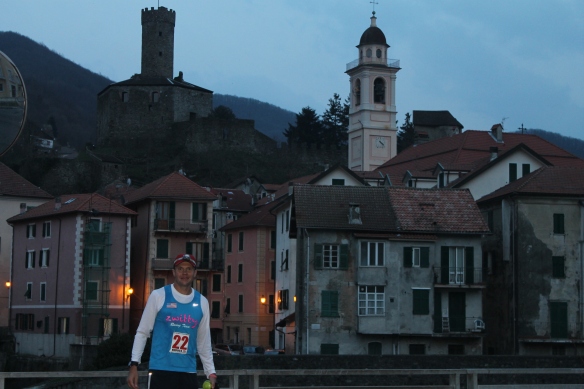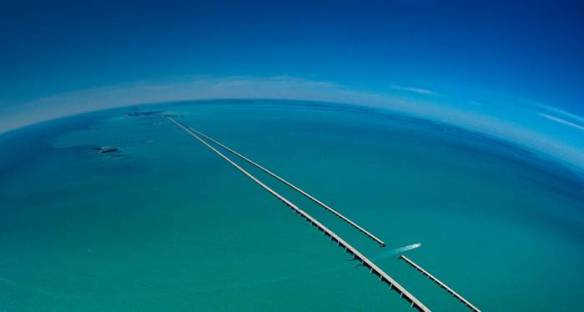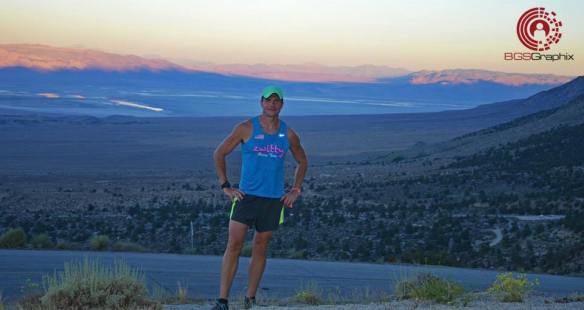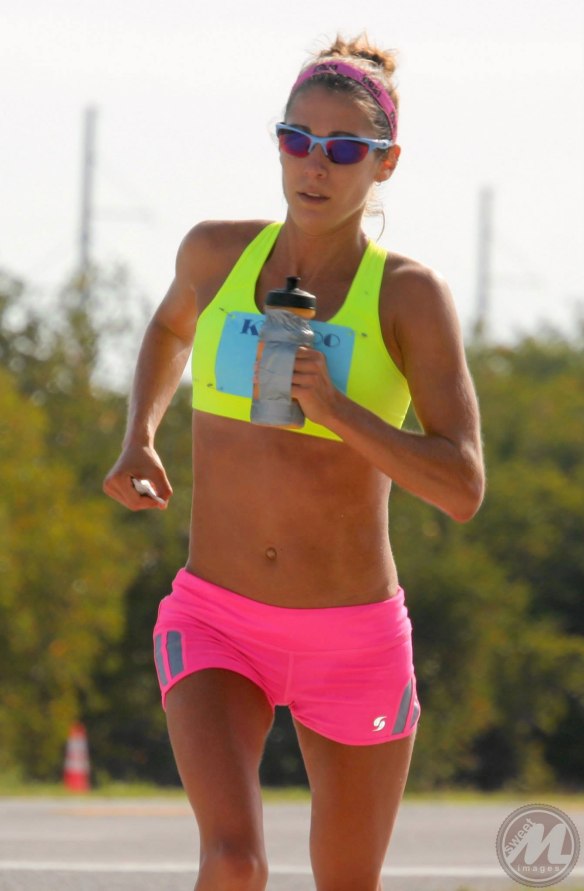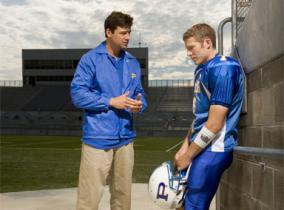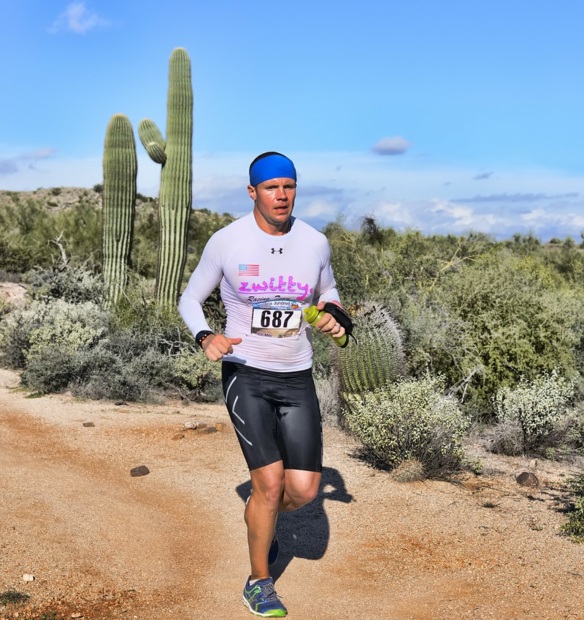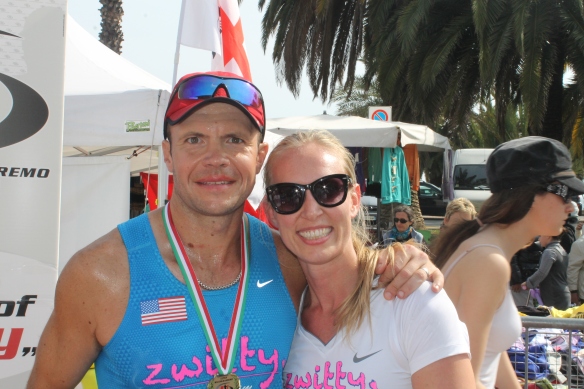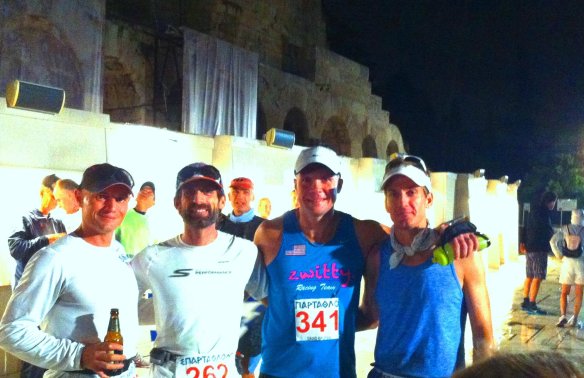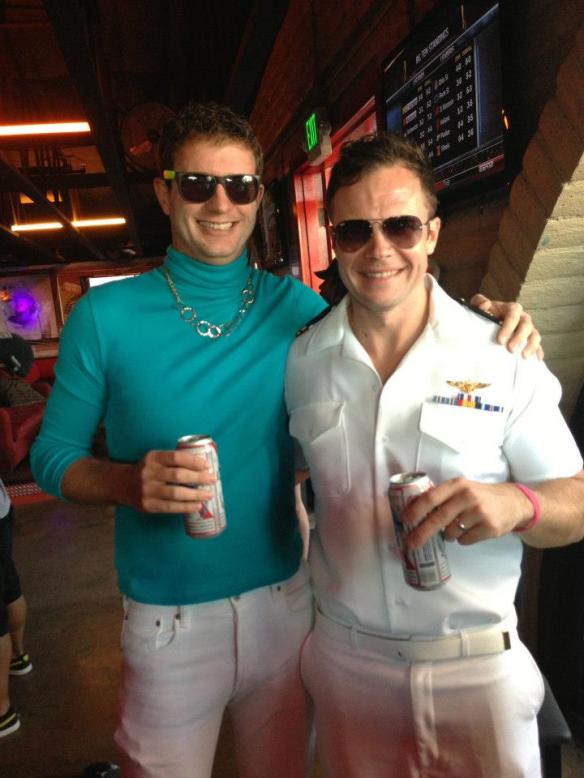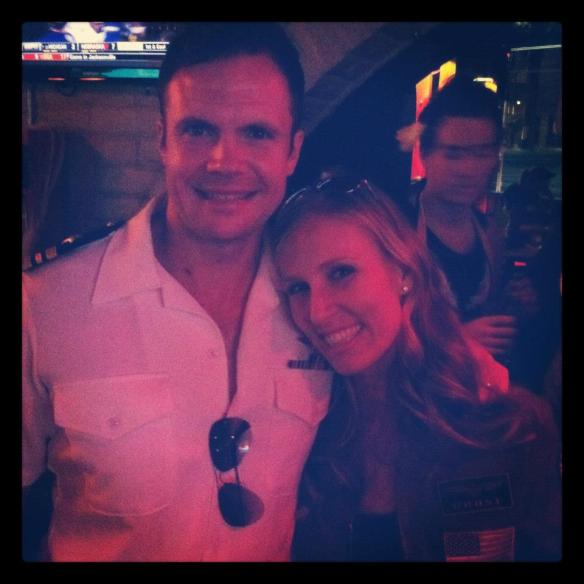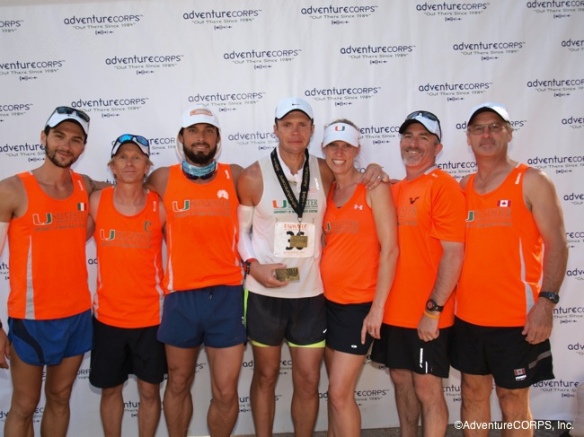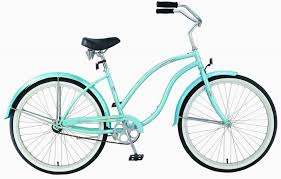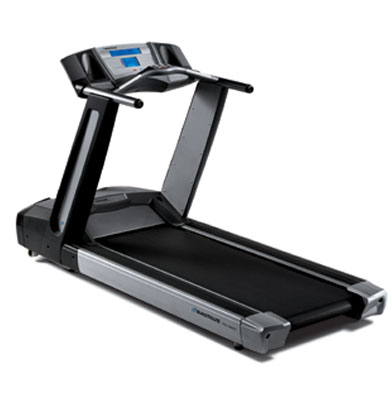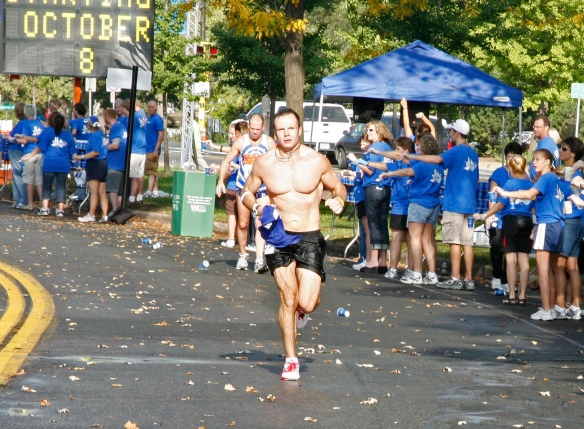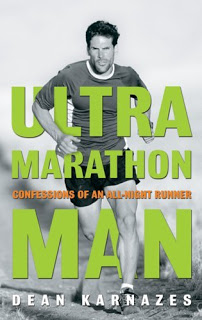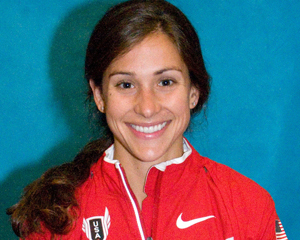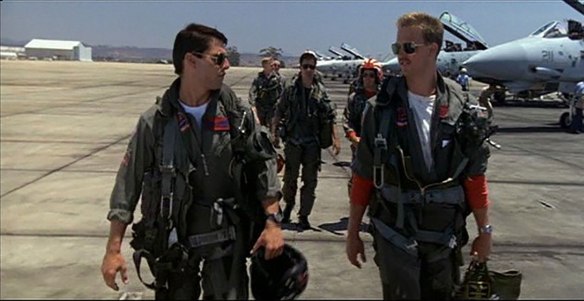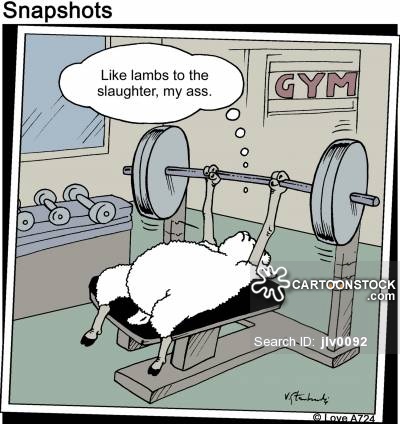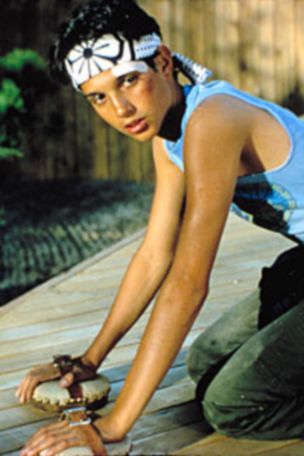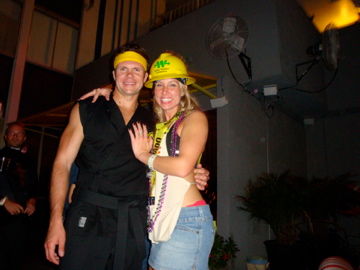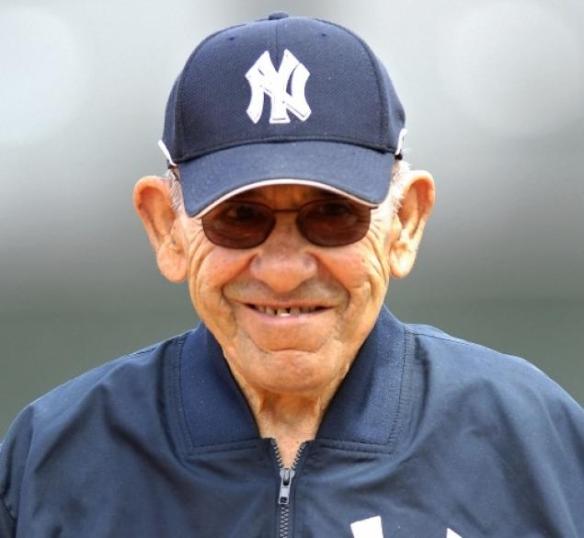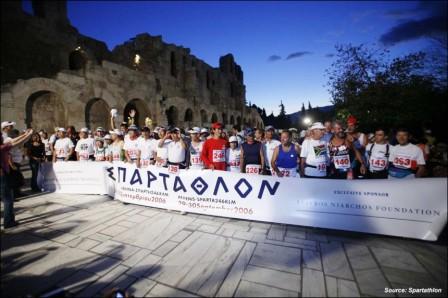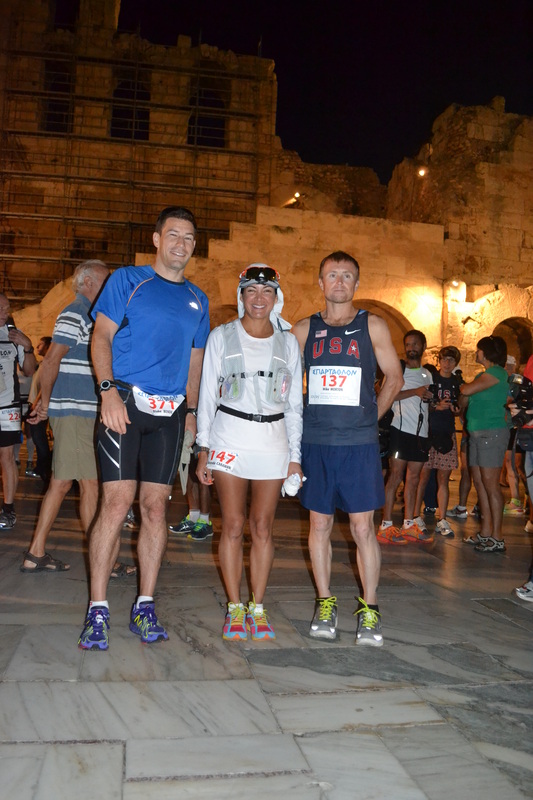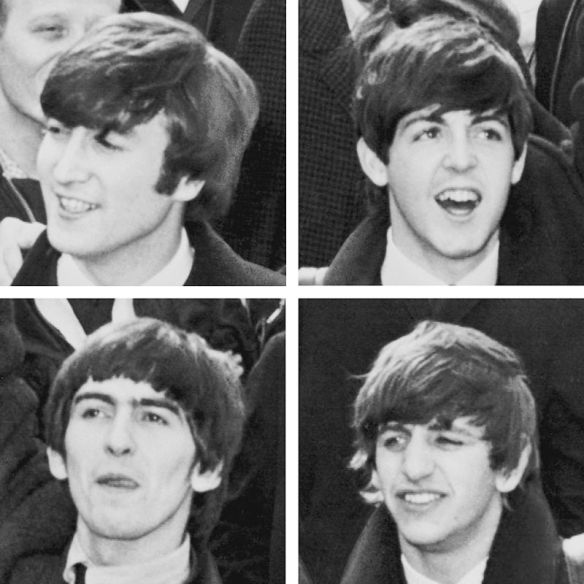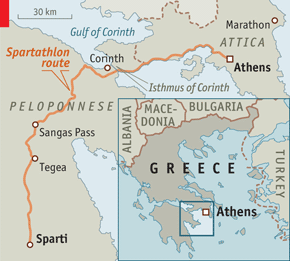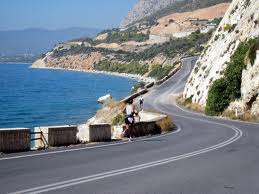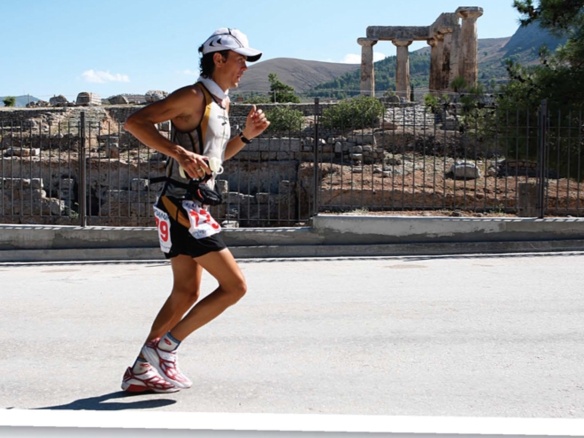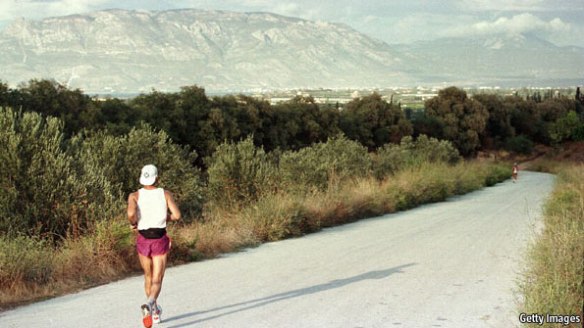1. Introduction. 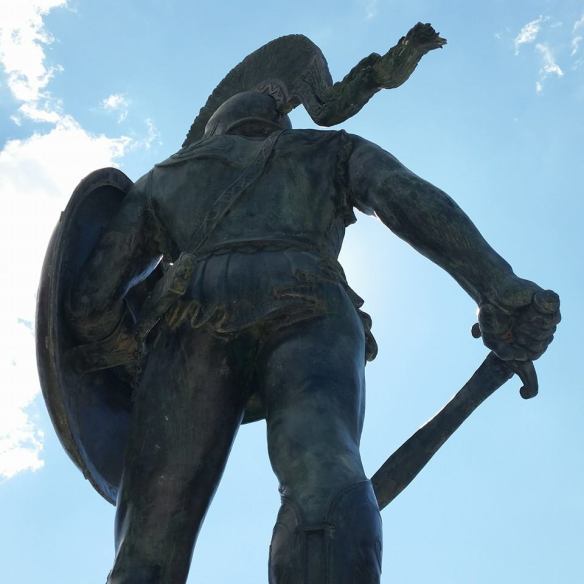 It’s been about 36 hours since I’ve gotten back to Florida from my week-long trip to Greece for the Spartathlon. And the one phrase that keeps coming to mind when I reflect on this trip is “over the top.” That phrase truly describes everything about the trip: the Greek hospitality, their enthusiasm/passion for the Spartathlon, the course itself, its level of difficulty, the substantial mountain you must pass over at exactly Mile 100, and the pressure of the time cutoffs (36 hours for 152.4 miles, with 75 checkpoints in-between). “Over the top” also describes the ridiculous financial bargain of this race. What you get for $550 is, quite simply, ridiculous. (More on that later).
It’s been about 36 hours since I’ve gotten back to Florida from my week-long trip to Greece for the Spartathlon. And the one phrase that keeps coming to mind when I reflect on this trip is “over the top.” That phrase truly describes everything about the trip: the Greek hospitality, their enthusiasm/passion for the Spartathlon, the course itself, its level of difficulty, the substantial mountain you must pass over at exactly Mile 100, and the pressure of the time cutoffs (36 hours for 152.4 miles, with 75 checkpoints in-between). “Over the top” also describes the ridiculous financial bargain of this race. What you get for $550 is, quite simply, ridiculous. (More on that later).
The only thing “Over The Top” really does NOT refer to here is the craptastically-cheesy 1987 Stallone movie about arm-wrestling truck drivers: 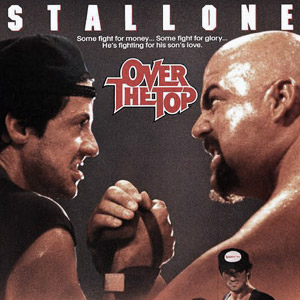 (“Some fight for money . . . Some fight for glory . . . He’s fighting for his son’s love.” Wow. Some Hollywood exec actually green-lighted this movie.)
(“Some fight for money . . . Some fight for glory . . . He’s fighting for his son’s love.” Wow. Some Hollywood exec actually green-lighted this movie.)
Okay, without further adieu, here’s my view on how Spartathlon 2014 went down:
2. The Two Days Before the Race.
Like most international athletes, I arrived in Athens on Wednesday, and therefore had two days to relax, adjust (somewhat) to the 7-hour time difference, and prepare for the Friday morning race start. The race officials put the American team up in the Best Western Fenix hotel, which is in Gylfada, a beachside suburb about 10 miles southwest of downtown Athens. The hotel was modern, clean, and was literally across the street from the sea.  (The beach across the street from the hotel was gorgeous. The water is completely clear and jumping in for a swim a few days after the race was VERY relaxing.)
(The beach across the street from the hotel was gorgeous. The water is completely clear and jumping in for a swim a few days after the race was VERY relaxing.) 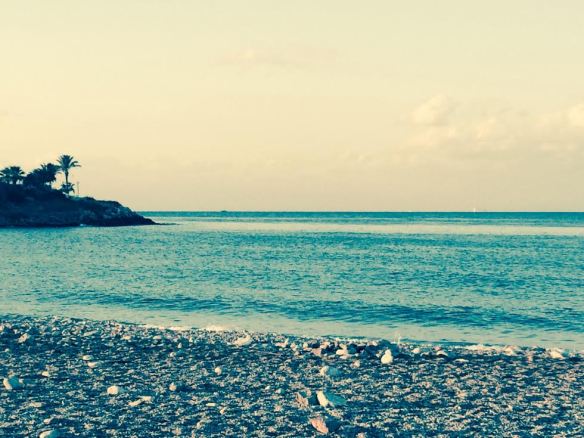 (One more shot of the beach, at a different time of day. This was not an ugly place.) 🙂
(One more shot of the beach, at a different time of day. This was not an ugly place.) 🙂
The USA Spartathlon team consisted of Jon Olsen, the world’s reigning 24-hour champ, Rob Youngren (who has finished Hardrock 4 times and just finished Badwater in the top-10), Bryce Carlson (owner of a 16:30 100-mile PR), Maggie Beach (who has run just about every tough race out there), Ed Aguilar (a chiropractor from LA who has lived in Italy for the past 18 years), my buddy Andrei Nana (who ran the race last year in just under 31 hours), as well as Dean Karnazes, the most famous ultrarunner on the planet who was running Spartathlon for the first time. I was honored to be included with such a group of accomplished runners and good friends.
For the trip, I roomed with Rob and probably spent the most time with Rob and Bryce. (Andrei was there with his wife Claire, they got engaged in Greece at this trip last year, and they understandably planned a lot of “alone” time during the trip). 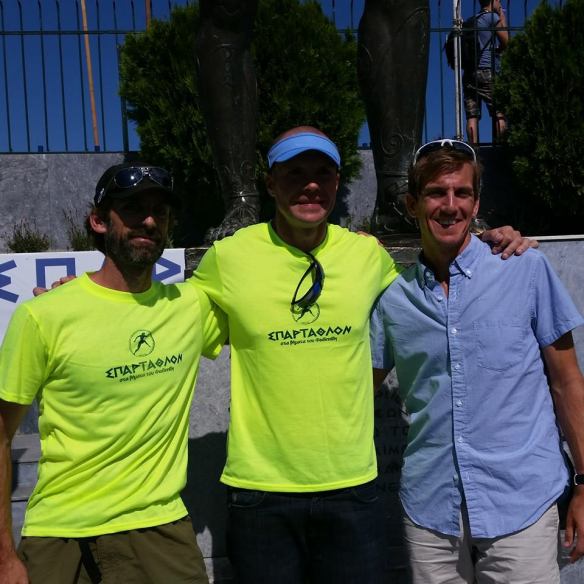 (Rob, Bryce, and myself at the finish line statute of Gerard Butler . . . er, King Leonidas, the day after the race)
(Rob, Bryce, and myself at the finish line statute of Gerard Butler . . . er, King Leonidas, the day after the race) 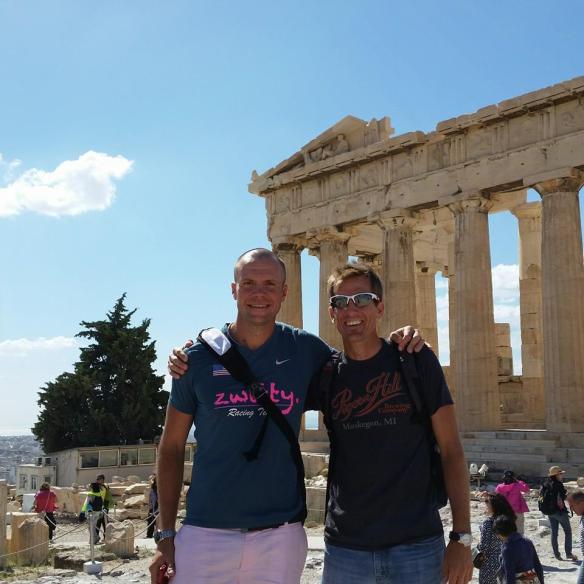 (Bryce and I at the Acropolis a few days after the race)
(Bryce and I at the Acropolis a few days after the race) 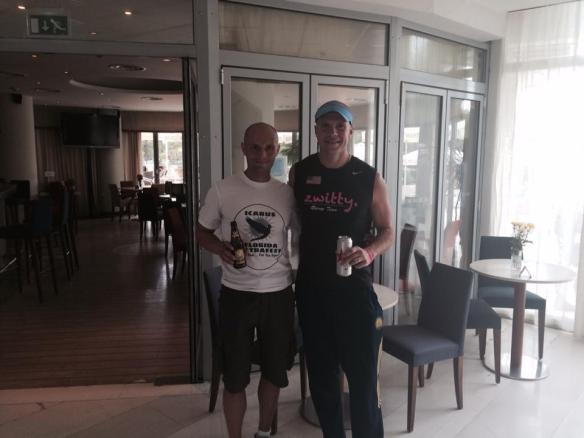 (Andrei and I relaxing just before the pre-race meeting the day before the race)
(Andrei and I relaxing just before the pre-race meeting the day before the race)
After the two days of preparing and relaxing were over, we were ready and anxiously awaited the 6am bus ride from our hotel on Friday morning to the Acropolis, for the 7am start of the race. With the task in front of us (a challenging 153-mile run with tight cut-offs, as well as the deepest field of international talent at any road ultramarathon on the planet), it was easy to feel a bit anxious. I usually sleep like a rock the night before the race, but for this one, I was tossing and turning pretty much all night long. By about 4 am, I just said, “screw it”, and got up…
3. Race Day: The First 26 Miles.
We arrived at the Acropolis about 45 minutes before the start, and at exactly 7am, we were off. It felt good to finally be running. I quickly settled into my pace of 8 min per mile. I just planned on running 8’s for the first 30 miles, and then 9’s from 30-50, for a 50-mile split of around 7 hours. (The 50-mile cutoff is 9:30, which is not terribly hard on a good day, but is a big problem if you are having issues/a bad day). By mile 2, I hooked up with Jon Olsen, one of the serious race favorites. He also was locked into an 8-min pace, so we just ran together for the first 3-4 hours. 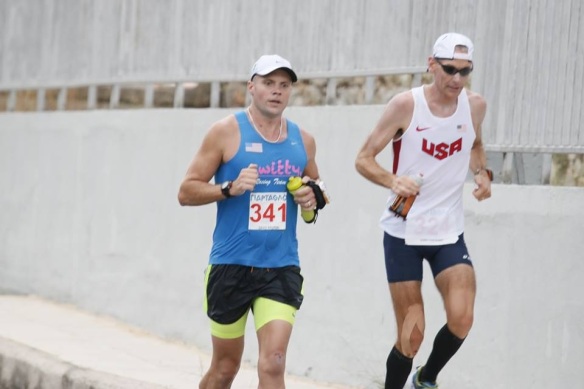 (Running with Jon around Mile 10)
(Running with Jon around Mile 10)
The first 25 miles are not particularly scenic, as you have to run out of urban Athens before you hit the sea. Once the Saronic Gulf is reached, however, the course truly opens up and becomes quite beautiful. So I was extremely glad not to be alone for this first section, as I generally hate the first few hours of an ultra until I get into a good running rhythm. Jon was awesome to run with, as he is very easy-going and laughed at all of my jokes. (Which CLEARLY means he has an impeccable sense of humor!) 🙂 Actually, we had a lot in common, such as playing a Division I sport in college other than running (baseball for me, football for him . . . he was a middle linebacker. Or a punter. Look at the picture above and decide for yourself).
We both also have wives who couldn’t make the trip because they just started grade-school teaching jobs at new schools. By the time we reached the marathon point (Megara), I told Jon to continue on without me, as I was starting to develop a bit of a stomach issue. That was the last time I saw him during the race. I crossed the marathon point at right around 3:40, so a bit over 8:00/mile.
4. Megara to Corinth (Miles 26-50).
This section is defined by incredible beauty (of running along cliffs that overlook the sea) and then incredible dullness (of running by a succession of factories). Once the course crosses the Isthmus of Corinth, you leave Attica and are on the Peloponnese Peninsula, and the course switches quite drastically from urban to agrarian: 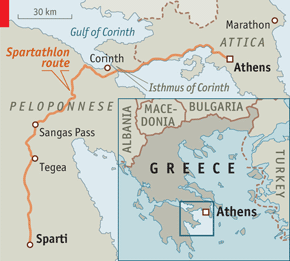 (The Spartathlon course) My small stomach discomfort at the marathon mark turned into a full-blown issue by the 50k (31 mile) mark, at which point Andrei passed me.
(The Spartathlon course) My small stomach discomfort at the marathon mark turned into a full-blown issue by the 50k (31 mile) mark, at which point Andrei passed me. 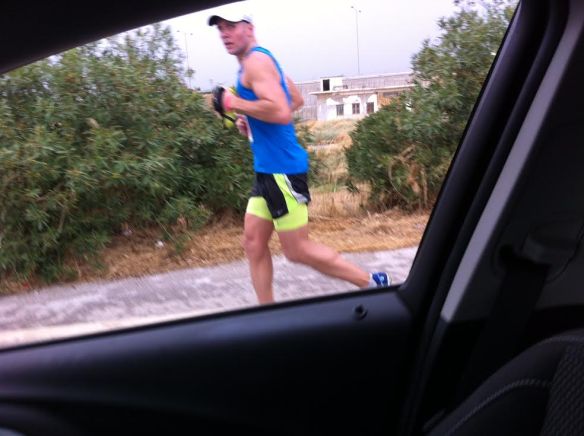 (Struggling a bit at the 50k mark) This is also the point, however, where we really started to get great views of the sea, which was invigorating.
(Struggling a bit at the 50k mark) This is also the point, however, where we really started to get great views of the sea, which was invigorating. 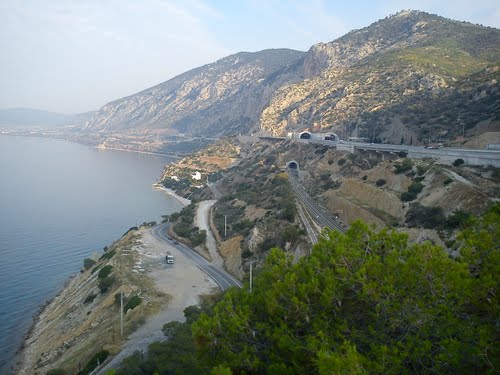 (The race road around the 35 mile mark).
(The race road around the 35 mile mark). 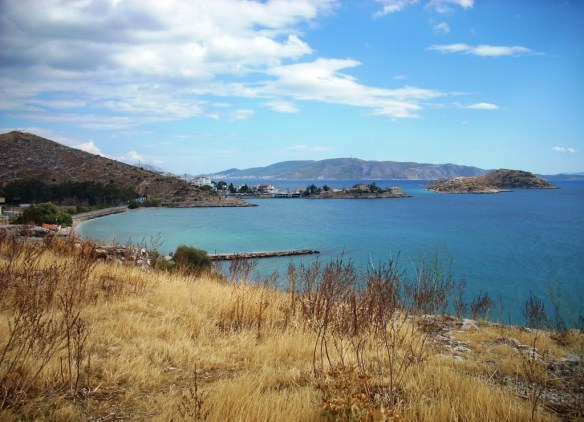 (View of the sea from the race road; pretty decent scenery, huh?) 🙂
(View of the sea from the race road; pretty decent scenery, huh?) 🙂
Andrei passed me after a few miles, and I would not see him for quite a bit later down the race. It also started lightly raining during this time, which was really nice. It even got a bit chilly. A Brit named Sam Robson flew by me at this point and commented that it felt like “a gorgeous summer day in London” during this spell of rain. A few miles up the road, I ran into Dean Karnazes, and we ran together for about the next 10 miles. He was running the entire race on only olives, figs, and cured meats — to mimic the likely diet of the “original” ultrarunner (Pheidippides) — and, along with me, he was not liking life very much at that point. It didn’t help that after the quick bout of rain, the skies cleared pretty rapidly and the temperatures soared into the upper 80s with high humidity.
By Mile 40, I was reduced to a run/walk (with a lot more walking than running). Dean dropped me — as did a TON of people — during this stretch, and I knew I wouldn’t be anywhere near my 7-hour goal for the first major checkpoint of the race at Mile 50. With a few miles to go until the big checkpoint, Rob and Bryce both caught up to and passed me. I was struggling to keep a steady pace. This was my “low” point in the race; it was just happening really, REALLY early. With over 100 miles STILL to go, and the cutoffs looming ever more closely with each mile that I walked, I was not in a good place mentally for this stretch of the race. I just kept telling myself, “just get to Corinth; just get to Corinth.”
5. Corinth to Nemea (Miles 51-77). 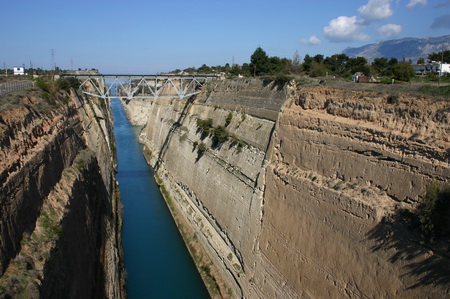 (The man-made Isthmus of Corinth, providing a thru-way of the most narrow part of the Peloponnese Peninsula to the Saronic Gulf and Attica)
(The man-made Isthmus of Corinth, providing a thru-way of the most narrow part of the Peloponnese Peninsula to the Saronic Gulf and Attica)
When I finally reached the Mile 50 Corinth checkpoint in about 8:15, I was in pretty bad shape, and I was only a little over an hour ahead of the cut-offs. I decided to sit down for the first time in the race, take 5 minutes (which for me is an eternity at an aid station), restock some supplies (my first drop bag was at Corinth), and, most importantly, “flip the script” mentally. I was not thinking positive thoughts for the past 10 miles, and I was running defensively. I decided right there that I needed to force myself into a positive mindset, and focus on two things: building up more of a buffer on the time cutoffs, and passing as many people as possible for the remainder of the race. (With the unbelievable depth/quality of this field, I was likely not even in the top-150 at this point, so I had PLENTY of “rabbits” out in front of me to catch).
When I got up and left the aid station, I had a tad over an hour on the cutoffs, but I was in a much-better place mentally, and I was going to be in “attack-mode” for the rest of the race. I was also going to enjoy myself a lot more. I was in the middle of the greatest international road ultramarathon in the world, after all. I probably repeated “flip the script” about 100 times to myself for the first few miles out of the aid station. It started to work. I quickly passed 5, then 10 people in front of me. I was finally moving like I knew I could. I still had 100 miles to go, but for the first time in the race, I started to feel comfortable and like I was “taking it” TO the race, not the other way around.
I’m a huge nerd, which goes hand-in-hand with being a Star Wars fan. In The Empire Strikes Back, there is a scene where Luke tries to use “the force” to lift his X-wing out of the swamp on Degobah. When he fails, and sees Yoda subsequently succeed, he says “I don’t believe it.” Yoda replies, “THAT is why you failed.” THAT is ultrarunning in a nutshell. We run these insane distances, and in races like Spartathlon, are forced to do it pretty quickly. Self-belief and a positive attitude are the most important ingredients to success.
After I committed myself to always staying positive no matter how shitty I would later feel (which, believe me, was often), my race turned around. Scenery-wise, this section was drastically different than the first 50 miles. While that first section was urban sprawl, we were now in the Greek countryside, going through olive groves, orchards, wine vineyards, and very small country towns:  One of the biggest factors in helping me stay positive throughout the race was the UNBELIEVABLE passion of the Greek people during the race, especially in the small country towns. Scores of people cheer like crazy when you enter the town. Hundreds of kids line up to get high-fives, and I was asked for my autograph at least a dozen times in these small cities. (I obliged every time; while to an American, the situation may seem a bit silly — a Greek kid asking a random American for an autograph — their faces all lit up whenever we obliged, so it was an easy call). The Spartathlon is now a part of Greek history, and one that honors one of the great stories of ancient Greek history (the feats of Pheidippides). Thus, the race has really become part of the fabric of Greek culture. I’ve never experienced this in ultrarunning; in most U.S. races, people look at you with mild bemusement at best. But in Greece, genuine emotion and passion was just pouring out of people. It was really, really inspiring to be a part of such a powerful event.
One of the biggest factors in helping me stay positive throughout the race was the UNBELIEVABLE passion of the Greek people during the race, especially in the small country towns. Scores of people cheer like crazy when you enter the town. Hundreds of kids line up to get high-fives, and I was asked for my autograph at least a dozen times in these small cities. (I obliged every time; while to an American, the situation may seem a bit silly — a Greek kid asking a random American for an autograph — their faces all lit up whenever we obliged, so it was an easy call). The Spartathlon is now a part of Greek history, and one that honors one of the great stories of ancient Greek history (the feats of Pheidippides). Thus, the race has really become part of the fabric of Greek culture. I’ve never experienced this in ultrarunning; in most U.S. races, people look at you with mild bemusement at best. But in Greece, genuine emotion and passion was just pouring out of people. It was really, really inspiring to be a part of such a powerful event.
6. The Calm Before the Storm — Nemea to Lykria (Miles 77-92).
I reached the second major checkpoint, Ancient Nemea (Mile 77), approximately 14 hours into the race. I had run well enough in the previous section to double my buffer on the cutoffs (I was now over 2 hours ahead of them). Nemea was a party atmosphere with hundreds of spectators, bands, and plenty of warm food. So, naturally, I high-tailed it out of there as quickly as I possibly could, for fear of getting TOO comfortable there. It was now dark outside, and this 15-mile section ending at Lykria — at the base of the most substantial mountain in the race — is pretty easy from a terrain standpoint; just a lot of rolling hills, followed by a sustained downhill into Lykria. So I just focused on maintaining a good pace and losing myself in the race and its rhythm.
A few miles into this section, around Mile 80, I caught up to Dean again, who was surprised to see me. “I was worried about you back there.” “Yeah,” I replied, “I was in a bit of a rough spot, but I’m back now.” “I can see that.” We then hung out for the next 10 miles and traded some war stories, generally joked around, and actually had a pretty good time; despite the fact we were over 80 miles into the race, we pretty much ran that whole section. He thanked me for “pulling him” through it, and then I pulled ahead of him around Mile 91, about a mile before the third major checkpoint in Lykria. I was fully “in the zone” now, so to speak, and Dean was still hurting a bit, so I knew that this would probably be the last time I saw him during the race. So I said “keep it up,” “get ‘er done,” and probably a few equally silly phrases, and was on my way.
Coincidentally, I ran with and passed Dean for good at Mile 91 at Badwater last summer as well. I’ve said this before; Dean sometimes gets caught up in controversy, as his celebrity status/financial success is the envy of runners everywhere, but in person, he is a VERY down-to-earth and nice guy. I really enjoyed running with him out in Greece, and look forward to the next time we share the same course (which I’m sure will be soon enough).
7. Over the Top of the Mountain — Lyrkia to Nestani (Miles 92-108).
After the last five miles of quad-pounding downhill miles, I was actually looking forward to the eight-mile climb up to Sangas Pass from Miles 92-100, which is the highest point and toughest climb of the race. The final mile of the climb is on a trail of VERY loose rocks and grades so steep you are literally on your hands and knees much of the way up. Over the course of eight miles, you climb almost 4000 feet, much of it at a 20% grade. 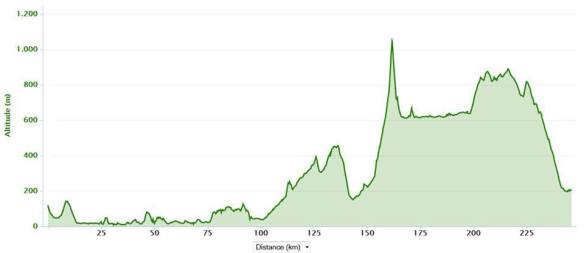 (As you can see, the mountain is basically straight up for 8 miles)
(As you can see, the mountain is basically straight up for 8 miles)
For some completely unknown reason, over the past few years, I’ve actually developed into a decent climber during races. (I say “unknown” because I live in Florida and do virtually no hill training). At any rate, I was really strong on the 7 mile climb up to the final trail mile, and I hit the Mile 99.1 aid station in about 18:50. (Originally, I wanted to be about 2 hours faster through 100 miles, but for my first Spartathlon, I’ll take it) 🙂 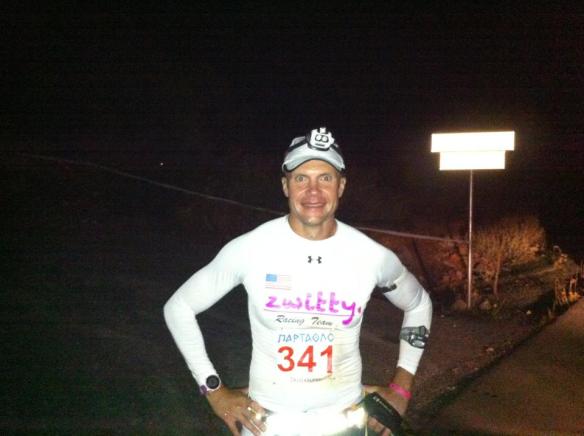 (At Mile 99 and one trail mile to go to the top (Sangas Pass))
(At Mile 99 and one trail mile to go to the top (Sangas Pass))
The trail itself was just silly. One mile, and about 1000 feet of vertical climb, so basically straight up. The footing was loose and terrible, so I just put my head down and tried to get it over with as quickly as possible. As a lot of people know, I am not at my most comfortable on rough, “technical” trails, so I just really wanted to get it over with. Perhaps the only person I know who is less comfortable than me on trails is my buddy Andrei, who I caught up with and passed on this mile-long trail. He looked miserable at the time, but he’s the toughest guy I know, so I was sure he would rebound and finish the race (which he did).
Once I got to the top of the race, the next mile — going DOWN the loose-rock trail on the other side — was absolutely miserable. My energy levels were great and my legs felt fresh, but I was basically doing baby steps down the other side of the mountain until I got off the trail, for fear of falling and seriously injuring/killing myself. I must have gotten passed by 10 people on this mile-long down trail. I happily let them go, knowing that I would be seeing them very soon as soon as the path rejoined the road. Once we did get back on the road, I started running again for the first time since the start of the climb. It took about a mile to get back into rhythm, but when I did, I was flying. It felt great — I was running sub-8 minute miles for about 5 miles into the Nestani aid station, and I passed all the people who passed me on that trail, along with a few others.
When I reached Nestani at Mile 108, I had built up a 3-hour buffer from the cutoffs. This is the point I stopped looking at the cut-off times when I got to each checkpoint; I knew they wouldn’t be a problem anymore.
8. One Last Energy Low — The Plains of Tripolis, Nestani to Ancient Tegea (Miles 108-122).
The 15 miles from Nestani to Tegea are the flattest of the course, and sunrise occurred during this section. The 110 miles already run was beginning to take its toll on my legs and on my energy level. I knew that once I reached the last major checkpoint of Tegea, I would only have a 50k (31 miles) to go until I met King Leonidas in Sparta, so I just put my head down and tried to get the miles done as quickly as possible.
9. Meeting the King — Tegea to Sparta (Miles 122-152.4)
When I reached Mile 122 and Ancient Tegea — which was visually really cool — it was about 8:15 am, so a little over 25 hours into the race. I was tired, sure, but the daylight as well as the fact that I was so close invigorated me, and made a point to only stay in Tegea for a few moments until heading out for the final push.  (Ancient Tegea)
(Ancient Tegea)
I unfortunately learned in Tegea that Jon Olsen, the top American in the race, had dropped out with about 20 miles to go, due to thermoregulation issues. He’s a great guy and super-talented, and I have no doubt he will be back at some point and probably win the race. The list of Americans who have dropped out during their first attempt at Spartathlon reads like a who’s-who of world-class ultrarunning. Some absurdly-talented guys have dropped out of this race. It really is that tough.
After leaving the Tegea aid station, I felt probably the best I had the entire race. I was FLYING for a mile or so until I hit a rude surprise . . . the final major climb of the race. It was probably about 1200 feet of vertical over about 5-6 miles, so the grade wasn’t bad, but this climb just seemed to never end. But once that climb is over, the last 22 miles are pretty much all downhill, so while this section will kill your quads, you can move pretty quickly into Sparta for the finish.  (View coming into Sparta)
(View coming into Sparta)  (Another gorgeous view heading into town)
(Another gorgeous view heading into town) 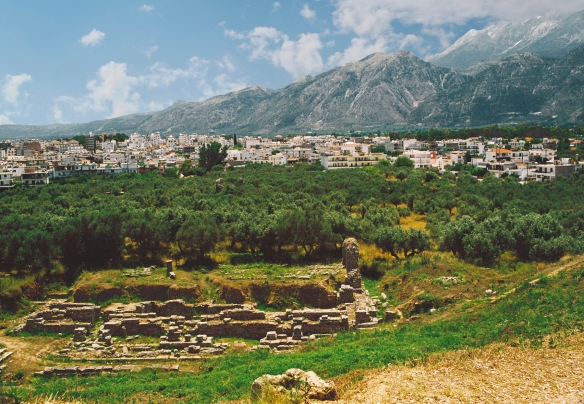 (Sparta)
(Sparta) 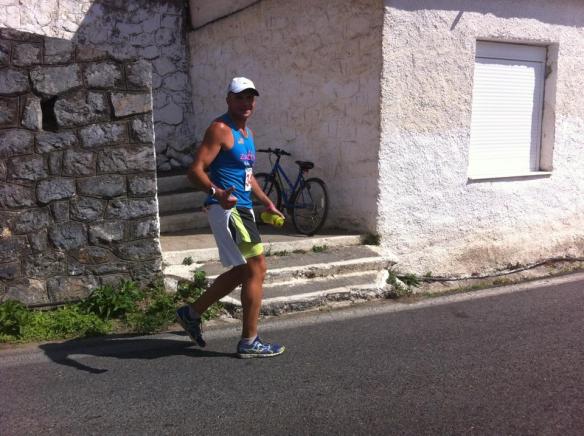 (Last 5 miles…) When I made the final turn on the street with the King Leonidas statute at the end, it was like nothing I have ever seen in ultrarunning. The street, lined with restaurants, bars, etc., was FILLED with thousands of people who ALL cheer wildly for you when you pass. They make everyone feel like they won the race; it’s just insane. And the last 100 yards or so, about a dozen kids join you and run you in to the finish. It is just spectacular.
(Last 5 miles…) When I made the final turn on the street with the King Leonidas statute at the end, it was like nothing I have ever seen in ultrarunning. The street, lined with restaurants, bars, etc., was FILLED with thousands of people who ALL cheer wildly for you when you pass. They make everyone feel like they won the race; it’s just insane. And the last 100 yards or so, about a dozen kids join you and run you in to the finish. It is just spectacular.  (About to pick up my entourage of a bunch of 10-year-olds…) 🙂
(About to pick up my entourage of a bunch of 10-year-olds…) 🙂 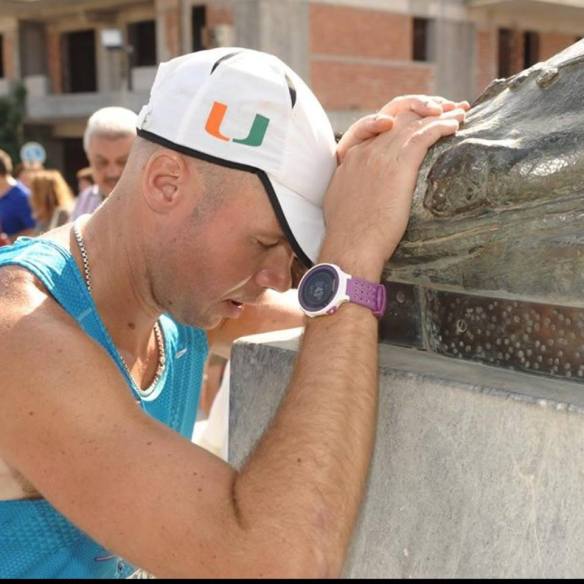 (The race is over when you touch the foot of the great King Leonidas; I’d be lying if I said this wasn’t a hugely emotional moment, after running over 152 miles…)
(The race is over when you touch the foot of the great King Leonidas; I’d be lying if I said this wasn’t a hugely emotional moment, after running over 152 miles…) 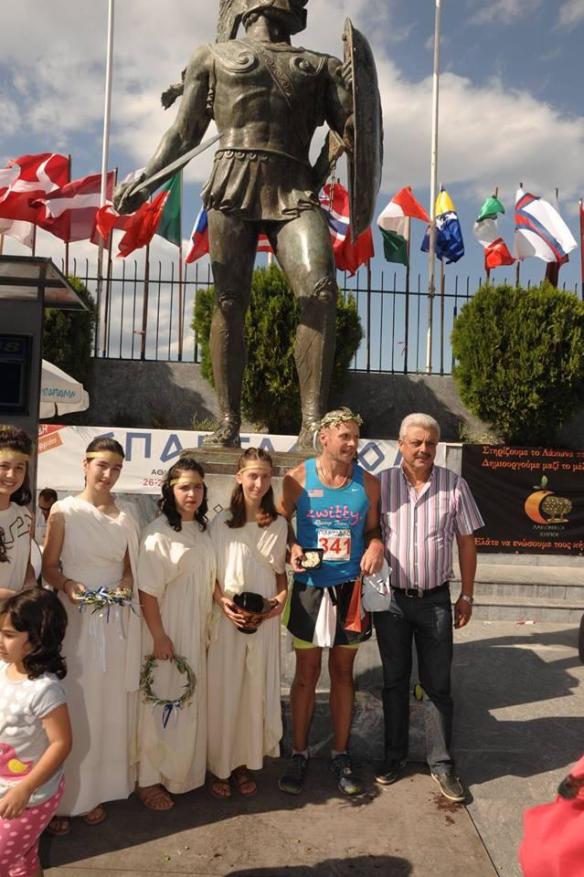 (Every finisher is presented with an olive wreath, a VERY cool medal, some water from the Evrotas River, and all sorts of other things).
(Every finisher is presented with an olive wreath, a VERY cool medal, some water from the Evrotas River, and all sorts of other things).
I finished the race in 32:43. Bryce, Rob, and I all finished within about 40 minutes of each other, which was awesome. Andrei was about an hour behind, and Dean finished about an hour behind him. Ed Aguilar also finished the race. Of particular note, Hungarian-American runner Katy Nagy had an amazing race and finished as the second female overall, in a little under 29 hours. (The winner, Szilvia Lubics, won for the third time, setting the course record for women, in a bit under 27 hours. I met Szilvia at the Ultra-Milano Sanremo course this past March in Italy; there, I beat her by about 7 hours. Here, not so much.) 🙂
While I’m sure if I run the race again, I can improve my time by several hours, I doubt any subsequent trips will beat this one for me. Seeing the unbelievable amount of passion that is involved in the race was just really moving for everyone involved. This is a first-class event all the way; the runners are treated like royalty for the entire week.
10. Aftermath.
After we crossed the finish line, we were bussed about 10 miles away to a sweet resort right on the beach called the Belle Helene Hotel. It was easily a 4-5 star resort with unreal views of the Aegean Sea:  (Our hotel for the night after the race)
(Our hotel for the night after the race)  (View from our enormous personal balcony)
(View from our enormous personal balcony) 

 (More views of the hotel beach) The next day, we returned to Sparta to pick up our drop bags, and to have lunch with the mayor of Sparta. It was a great feast/celebration, set in a vineyard’s restaurant:
(More views of the hotel beach) The next day, we returned to Sparta to pick up our drop bags, and to have lunch with the mayor of Sparta. It was a great feast/celebration, set in a vineyard’s restaurant:  (Outside the restaurant for the lunch with the mayor)
(Outside the restaurant for the lunch with the mayor)  (Inside the restaurant)
(Inside the restaurant) 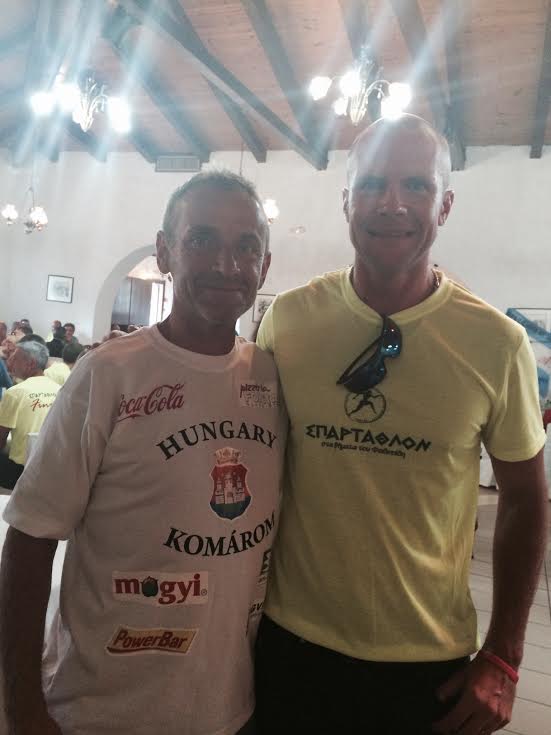 (With Szonyi Fenerc, a super-strong Hungarian runner who beat me — and came in second overall — at Ultra-Milano Sanremo in Italy in March, by SIX minutes!)
(With Szonyi Fenerc, a super-strong Hungarian runner who beat me — and came in second overall — at Ultra-Milano Sanremo in Italy in March, by SIX minutes!) 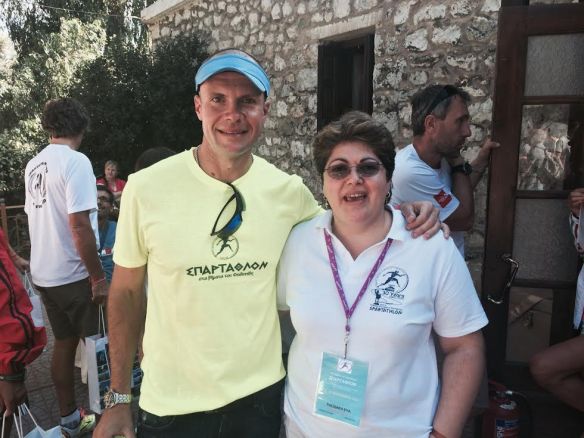 (With Eva, one of the many race volunteers. Eva works as a teacher for special-needs first-graders; she, along with all the other volunteers, happily gave up their entire weekends to be part of this special event)
(With Eva, one of the many race volunteers. Eva works as a teacher for special-needs first-graders; she, along with all the other volunteers, happily gave up their entire weekends to be part of this special event)
The Spartathlon represents, to me, the pinnacle of “pure” ultrarunning. It is run by a non-profit organization, the citizens care DEEPLY about the race, it is a formidable challenge amongst the deepest field in international road ultrarunning, and the value is . . . well, it’s just silly: The race costs $550. Here’s what that gets you:
-Registration into the race;
-5 nights’ stay at the Fenix Hotel (4 nights) and the Belle Helene Hotel (1 night);
-all meals included; -75 fully-stocked aid stations along the course;
-all transportation to and from all race events;
-THREE post-race celebrations (an awards ceremony the night of the race in Sparta, a lunch with the mayor of Sparta the next day, and the “main” ceremony: a more formal awards gala back in Athens on Monday after the race); and
-The swag. As if the above is not WAY over the top, here are all the physical things they bestow upon you as well: 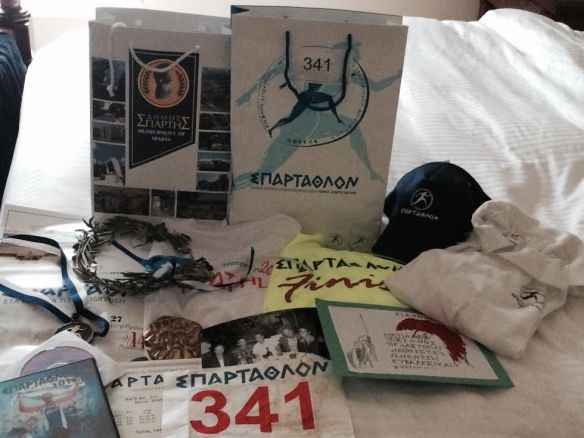 That consists of:
That consists of:
-race bibs;
-a particpation tech shirt;
-a finisher’s tech shirt;
-a race medal (around your neck);
-a really big race medal (in lieu of a buckle);
-an olive wreath;
-a hat;
-a finisher’s certificate with all of your splits listed;
-a celebratory certificate handmade by a local child;
-a CD loaded with pictures of you running during the race;
-a race DVD;
-photographs of your table during the awards gala, which are printed off and given to you before the night is over;
-a polo shirt; and
-shot glasses.
(The only things I had to pay for with my own money were the polo shirt ($5, seriously), and the shot glasses ($1 each)).
Needless to say, the race is by far the best deal in ultrarunning. As one of my new Brit buddies said the day after the race, “I’d use this as a super-cheap vacation even if I WASN’T running!”
11. The Final Day in Athens.
We arrived back in Athens late on Sunday night, and had Monday to ourselves before the awards gala at 8pm on Monday. Bryce, Rob, and I decided to head into town and check out the Acropolis/Pantheon and then take a dip in the sea before the gala. It was the perfect ending to the trip. 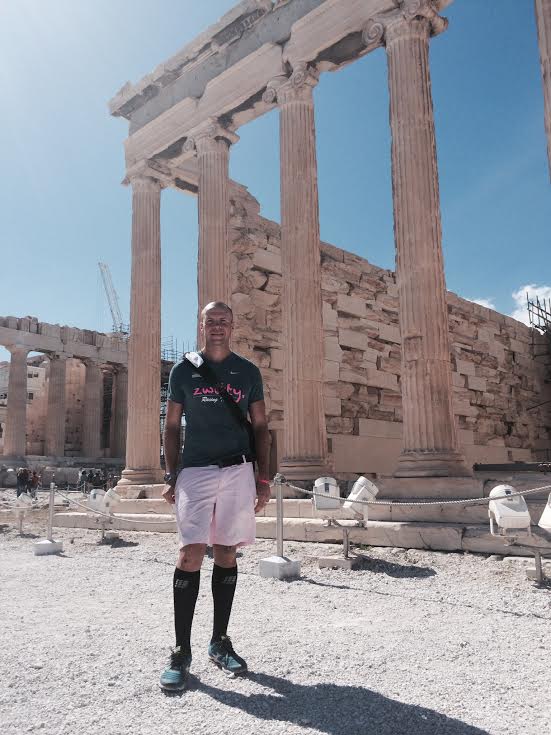 (At the Acropolis)
(At the Acropolis) 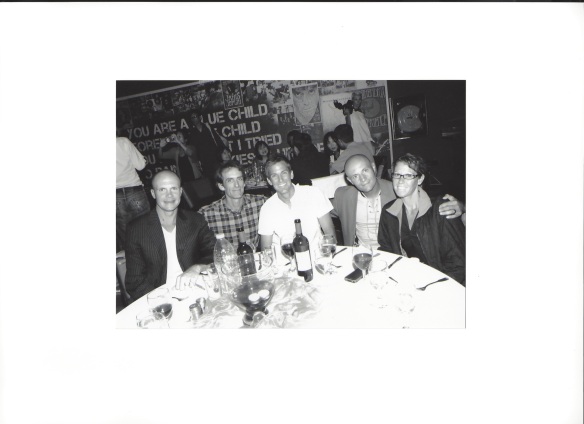 (At the awards gala with Rob, Bryce, Andrei, and Claire)
(At the awards gala with Rob, Bryce, Andrei, and Claire) 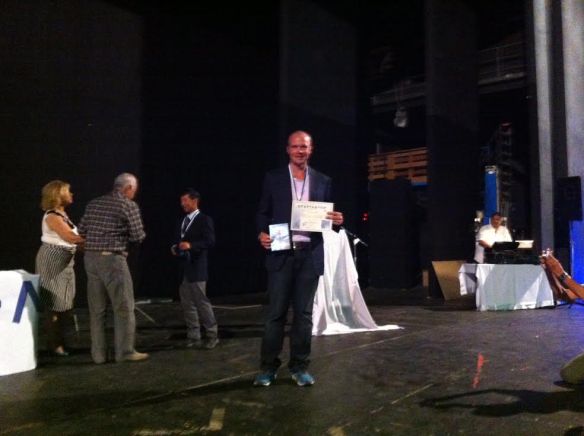 (Receiving my finisher’s certificate and medal at the gala)
(Receiving my finisher’s certificate and medal at the gala)
Overall, this was simply an outstanding experience, and, in my view, really represents the pinnacle of what ultrarunning is all about. I SINCERELY hope that for those of you that are in our sport, as many of you as possible get to experience this race, either as a runner or a supporter of a runner. It is just such a phenomenal race and experience in general. It’s unfortunate that the time cutoffs are so strict, and those cutoffs — as well as the stringent race qualification requirements — will inevitably mean that a lot of runners will not be able to qualify for the race. But think of it as our version of the Boston Marathon; it is hard to qualify for, and even harder to finish, but when you do, boy, it sure is worth every effort made to get there. 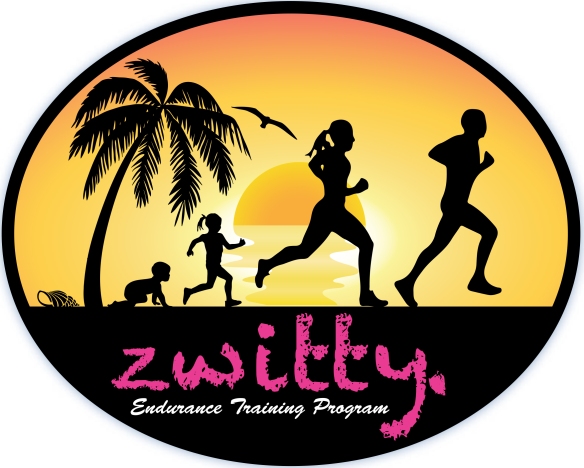 To that end, for anyone who sees Spartathlon as a goal in either their short or long-term future, I would be honored to work with you and help devise a plan to help get you there and be the one toeing the line at the Acropolis for this legendary race.
To that end, for anyone who sees Spartathlon as a goal in either their short or long-term future, I would be honored to work with you and help devise a plan to help get you there and be the one toeing the line at the Acropolis for this legendary race.
I launched the Zwitty Endurance Training Program about a month ago, and the response has been overwhelming to say the least. I still have some slots open, though, so go to www.davekrupski.com if you would like more information about my coaching services. Finally, thank you to the literally hundreds of you guys who followed me and cheered me and the rest of our team on out there; I could definitely feel your warm wishes during the race 🙂 I hope you enjoyed reading about this experience even a small fraction of the amount I enjoyed living it! See you guys “out there”!



